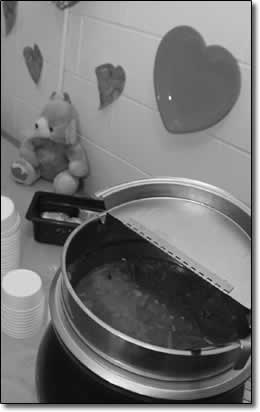|
Chains help offset district budgetary
shortfalls, but at what price?
Related Story: DHS Mixes up the menu

|
|
DHS freshman John Christensen sits down for lunch in the school cafeteria on Tuesday. The school offers everything from Domino's, Pizza Hut and burgers and fries, to fresh fruit, milk and salads. School District 9-R says serving fast food, which they often buy at a discounted rate, helps the district meet its budget. Fast food chains say it helps build product loyalty at a young age./Photo by Todd Newcomer.
|
by Adam Howell
On a typical day at Durango High School, students and staff at the cafeteria consume about 40
pizzas purchased from Pizza Hut and Domino's.
The cafeteria frequently sells out of the $1-a-slice pies, and they are the most popular lure for students, according
to Carol Melcher, the cafeteria's manager.
Other hot foods offered on the menu include cheeseburger with fries, corn dog with fries, beef tacos with refried
beans, chicken sandwich with fries, barbeque pork sandwich with coleslaw, and mozzarella sticks with marinara sauce.
They also offer sandwiches, wraps, soups and salads, among other things.
At the high school as at all schools in the district, the cafeterias follow U.S. Department of Agriculture
requirements for a food-based menu planning system, which requires that they provide a menu consisting of the
following: one serving of protein, like meat, poultry, legumes, peanut butter, etc.; two servings of fruit and/or
vegetable; bread; and dairy, usually milk or yogurt. Restrictions also are placed on the percentage of fat, sodium
and cholesterol in each meal, which also must provide a certain percentage of vitamins and minerals.
The pies from Pizza Hut and Domino's were added as an option during the past four or five years, according to the
School District 9-R Director of Nutrition, Kim Cotta. The school has tried other brands of pizza such as that from
the bulk commodity dealer, Andrews Produce Inc, but students did not like them. Pies from Pizza Hut and Domino's were
added as a choice at the DHS cafeteria to attract more students, Cotta explained at an Open/Closed Campus Task Force
community meeting last week.
Cotta added that she believes the cafeteria would limit fast food vendors in the cafeteria to pizza next year because
Durango would not support more. She said her research shows that high schools that implement a fast-food vendor court
sacrifice participation in the free and reduced National School Lunch program, which reimburses the cafeteria
financially for meeting nutritional requirements of the USDA. Students with a meal plan and those participating in
the state's free and reduced lunch program are required to buy more than just pizza, in order to provide a
USDA-approved balanced meal that is eligible for reimbursement, according to the cafeteria's manager, Melcher.
"If a kid comes through with just a piece of pizza," Melcher said, "I make him go back to get a juice or milk."
Melcher argued that in general, students are beginning to eat outside the pizza box more often. This is partially
because of the increased variety of foods offered in the cafeteria since the recent school renovation.
However, for students who do eat the pizza and other fast food items on a daily basis, nutritionists have significant
warnings. Myriad health repercussions can result from the high-calorie, high-fat content typical of fast food. This
is especially true if the diet is not accompanied by significant exercise. While pizza does provide refined grain in
its crust and tomato sauce as a vegetable - its high-fat content is a contributing factor to the development of
obesity, heart disease and high blood pressure, among other things.
Meanwhile, fast food companies are continuing to work within DHS to not just provide food, but also develop brand
name loyalty with the students in subtle ways. Locally, companies are giving pizza discounts to the school cafeteria.
Pizza Hut and Baskin Robbins give certificates to teachers to reward students who improve academically. Plus, student
clubs give away discounted Krispy Kreme Doughnuts as an incentive to join.
Similarly, Coca-Cola gives schools a commission on its vending machine sales that provides enticing budget support.
At Miller Middle School, the sales commission nets $2,000 to $2,500 a year to fund after-school programs for students
and other costs that the general fund cannot cover, Deborah Uroda, 9-R's Public Information Director, said.

|
|
A crock full of soup awaits the next hungry customer Tuesday in the DHS cafeteria. Although the school offers a bevy of healthier menu items, fast food pizza remains the most popular choice./Photo by Todd Newcomer.
|
Similarly, Coca-Cola gives schools a commission on its vending machine sales that provides enticing budget support.
At Miller Middle School, the sales commission nets $2,000 to $2,500 a year to fund after-school programs for students
and other costs that the general fund cannot cover, Deborah Uroda, 9-R's Public Information Director, said.
Since expenses exceeded revenues in the district last year, the district's food program had to be subsidized to the
tune of $35,000. This meant $35,000 less for academic programs to ensure that the district's students had the food
they needed to learn in the first place, Uroda noted.
While the high school also earns sales commission off Coca-Cola products, it has a strong relationship with fast food
pizza providers, whose popular products turn the revenues that are necessary to keep the cafeteria out of significant
debt. In turn, companies like Domino's and Pizza Hut are hoping this will help students remember their brand names.
"You would be surprised," said Katie Caudill, manager of Durango's Pizza Hut. "All it really takes is one time to get
someone hooked on something."
Pizza Hut, like other fast food chains, is discounting its tax-exempt products to high school students and is giving
some to elementary school students as a reward. The strategy, Caudill explained, is accepting lower profit margins up
front in order to develop brand-name loyalty to increase profits later.
At elementary schools throughout the district, some teachers are promoting Pizza Hut's Book It! program, Caudill
said. Including the 49,000 other elementary schools across the nation, around 21 million children participate in the
program, which awards students Personal Pan Pizzas for reaching targeted reading levels.
Domino's also discounts its tax-exempt pies to the high school, according to Ray Dimas, the owner of the local
Domino's. Dimas said he believes the chain's school sales help out the community while advertising the products to
students at the same time. gets our name out there," he commented.
Krispy Kreme Doughnuts is another case of a fast food company marketing its products to students by helping student
organizations with fund raising. At Durango High School, the Renaissance Committee gave Krispy Kremes as rewards two
weeks ago. Students with good behavior with grades above the D level were given a doughnut, according to student Jeff
LeFrance, the committee's president. The committee bought 72 dozen discounted Krispy Kremes to reward some 850
students. Students also had the option of accepting their reward in the form of baby carrots, he added.
"It's a cheap way to recognize students who are doing well," LeFrance said. And offering free food is a common tactic
used by many other clubs to get students to join, he said.
But marketing to students so they will develop a loyalty to a brand and come back to your store is not the point of
discounting Krispy Kreme Doughnuts to students, said Texaco 4 Star Store's Manager, Kevin Brennan. Instead, he said
his store discounts the doughnuts to student organizations like the Renaissance Committee and other community groups
in order to help them attain their goals, as a good will gesture.
What is a good will gesture for organizations is a delicious reward for students. For high school senior Scott
Cheesewright, the reward is acceptable. But eating habits in general, he said, would more likely be changed by first
altering the way people see normal eating patterns.
"So if we wanted to actually bring change it would not be from the way we reward people," Cheesewright said. "Because
if you change the way you reward it, people just won't see it as much of a reward."
|